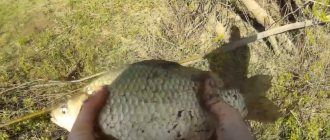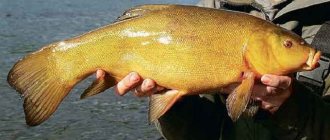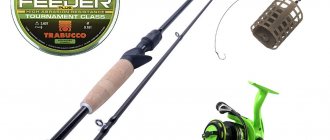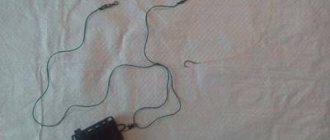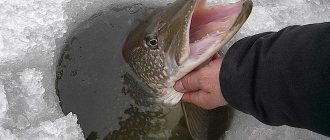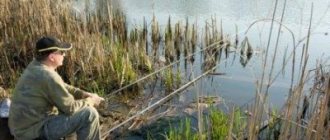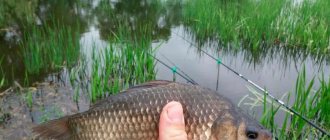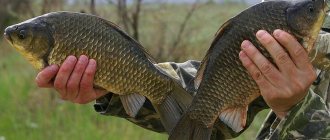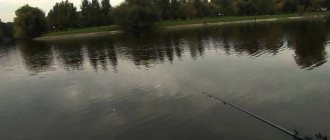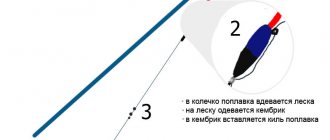Types of bait for a float rod with a feeder
Complementary foods are used depending on the type of reservoir.
It is divided into 3 varieties:
- Open. Here the feeder needs to be thrown into standing water and shaken with the filling. The bait will spread around the feeder. Here you need to quickly reel in the line and hook and direct them into the middle of the floating bait.
- Closed. This variety is used in small currents with bait in the form of worms or bloodworms, which will move quickly in the water and attract the attention of the fish.
- Spiral. This variety is universal. It is used in calm water, as well as in small currents. This feeder with a float is a sliding one and is very simply and conveniently attached to the fishing line. One of the negative factors here is the problem of the leash getting caught. This can be circumvented by knowing the mounting patterns.
This feeder with a float is of the loaded type. The main weighting agent is lead. They are used for fishing in deep water bodies. There is not much noise created here that could scare away the fish.
Let's celebrate! Since a large impact on the water creates strong noise vibrations, and there is also a risk of complementary food being thrown into the water.
The feeder is an excellent means of delivering food to great depths, where it will be easier for the fish to navigate.
Fishing rod equipment for catching crucian carp with a float
In 99% of cases, when using a float rod for crucian carp, you need tackle for fishing from the bottom.
When the crucian carp bites boldly and there is a hunger, coarse thick rigs also work. However, in spring and autumn in clear cold water, as well as in summer, when it has already eaten, this fish is often capricious. And he can simply not take the bait, spit it out if, when rising from the bottom, he feels a heavy weight or resistance from the equipment. The main requirement for equipping a fishing rod for crucian carp is maximum sensitivity. This is a fairly large fish - it easily moves and pulls a weight of 5, 10 grams or more. When it bites well. However, when testing the bait, sensing something is wrong, the crucian carp often stops trying to swallow the bait. Therefore, it is always better to use thin, neat rigs. Since the rude ones only work when they are hungry. The diagrams proposed below for correctly equipping a float rod for crucian carp have been tested over years of practice. And they are simple amateur equipment options, without unnecessary sports bells and whistles and expensive elements.
Blind equipment
Sometimes anglers argue which float equipment for crucian carp is better, blind or sliding. However, I think there is no difference - as long as the float is properly loaded. Mounting a fishing rod on a crucian carp can be done in any way. For long-distance casting, the sliding version is more convenient. Rigging a fly rod for crucian carp is rather a blind option. You can rig a Bolognese fishing rod for crucian carp this way or that way. The depth still rarely exceeds the length of the rod. Blind equipment is simpler, neater and more reliable. No stoppers needed. However, for long-distance fishing with depths of 3 meters or more, the sliding option is more convenient, since the float goes down to the sinker.
For example, I almost always fish with solid light floats with a spinning reel - even when the depth is under 5 meters. Yes, when casting a rig, when the float is right at the tip, inconvenience arises. But they can be solved by careful and precise casting, training and practice of casting the tackle. So it's more a matter of personal preference. Effective rigging for crucian carp can be done in both cases - this is more about loading the floats, choosing the diameter of the fishing line and hooks. It doesn’t matter how the float hangs, tightly or slides, as long as it’s done correctly.
Usually the float in the blind version is attached to the leg through a pair of cambrics. If there is a ring in the body, we pass it through it too. Also - a feather float, we plant it on 2-3 cambrics of the required diameter. Microfloats with a short keel and antenna - can be attached to one point
It is important here that the float sits firmly on the fishing line, but moves under force to adjust the depth. This is achieved by selecting the diameter of the cambrics and their density depending on the material
Small floats up to 3 grams are often deaf, while large floats are sliding. However, there are fans of small sliding floats, as well as large deaf ones.
Sliding float
In the sliding version, you can make a float tackle for crucian carp with your own hands from an ordinary blind float. To do this, you need to attach a metal or plastic loop to the leg. Ready-made connectors are also sold. The type of sliding float - with one point or two - depends on the number of such loops. The second ring is usually located in the float body itself.
The line passes through the rings, and the level of the float is adjusted with stoppers. The upper one is for setting the depth, the lower one is so that the float does not fall directly on the load and does not get confused with the leash.
- Rubber stops do not fit into the rod rings. Therefore, in the rigging of crucian carp fishing rods for long-distance casting, which are created for fishing at depths significantly exceeding the length of the rod, you need to use micro-stoppers, special knots that taper in the direction of departure with a cone - so that they pass the rings well when casting.
- In such equipment, the holes on the float itself also need to be small so that the microstop does not slip through. But this is already a rare case. At such depths it is easier to fish with a feeder or donka, so as not to have to worry about knitted stoppers.
- A sliding float with rubber stoppers is a universal tackle. But what is more important here is the correct loading itself, and not the method of attaching the float. A rod for catching crucian carp from the shore is usually 5-6 meters. This is enough for the near zone. But they can also be used for long-distance fishing. A properly equipped fishing rod for crucian carp is not a special tackle for this particular fish. Depending on the leashes and the size of the hooks, you can catch either carp or roach with it.
Detailed article - sliding float for crucian carp
How to make a float rod with a feeder?
You can make this fishing tackle yourself. Moreover, it is possible to make it more resistant to currents or other water obstacles.
It’s easy and simple to do, and the end result is a mini-feeder:
- You will need 1 wooden stick (can be used for sushi), which can be painted with water-based paint or black varnish;
- Then you can cut a strip 1 centimeter wide from any plastic bottle;
- You need to pierce 7 holes in it with a distance of 1 centimeter;
- You need to insert a wooden stick into the hole located in the very middle;
- One side of the plastic tape needs to be sealed with glue on one end of the stick;
- Both ends must be equipped with nipples, and the fishing line must be passed through them between the sinker and the float.
Fly fishing rod for crucian carp and its equipment
As you already understand, a fly rod is best suited for catching crucian carp. However, to get a good catch, you need to properly equip such gear. Therefore, having selected a fishing rod, we proceed to installing its equipment with our own hands. Here is a detailed diagram:
First of all, pay attention to whether there is a connector at the tip of the rod. This is a special clasp to which the main fishing line is attached.
If there is no connector, then you need to purchase and install it. Then we take high-quality monofilament fishing line with a thickness of 0.14-0.16 mm with a breaking load of about 2.5 kg. We make a loop and insert it into the connector. We measure the line somewhere to the middle of the rod handle. That is, before it starts, there should be about 20-30 cm left, necessary for leashes.
The next stage is fixing the float. To do this, the fishing line is threaded through a special eye (sometimes there are several of them). In addition, in order for the float to hold better and not slip, cambrics are placed on its keel or tip, which tightly hold the fishing line.
Then you need to install the leashes. It's optimal when there are two of them. Due to this, you can simultaneously fish with two baits and quickly understand which bait is in great demand among crucian carp today. To securely secure the leashes, use a triple swivel. Tie the main line to one eye, and use the other two for leashes. You can do without a swivel. Just make a loop through which you will attach the leashes using fishing carabiners. Why is this design convenient? Due to the loop, the leash can be easily changed to another if it breaks.
To install leashes, it is better to use a fishing line thinner than the main one by about a few hundredths of a millimeter. If there are two leashes, then they should differ from each other in length. This will reduce tangles
The longest leash can reach 15-20 cm, the shortest - 10-15 cm.
Now we tie the hooks. It is important to pay attention to their size and shape. For catching crucian carp, rounded hooks with a sharp sting and a short shank are most suitable. Their size can vary from No. 16 to No. 8, depending on the expected weight of the fish and the type of bait (bloodworm, dough, worm, etc.). Finally, all that remains is to load the gear
The weight of the sinker should not exceed the weight of the float. It is recommended to use several small pellets, which are distributed so that most of them are placed at the junction of the main line and the leaders.
Fishing technique and tactics
First you need to choose a place to bite, and also study the habits of the fish. Take a feeder and fill it with complementary foods.
The following ingredients can be used as complementary foods:
- Oatmeal or coconut flakes;
- Bran;
- Dry bread scraps and crackers;
- Floating boilies or pallets;
- Birdseed.
After filling the feeder, you need to throw it into the fish habitat. Then you need to keep a very close eye on the feeder and float. If it becomes clear that the fish has swallowed the bait, it will move in a certain direction.
Good to know! It will be necessary to make a sweep in the opposite direction. There are 2 types of complementary feeding techniques. This is casting bait with a float to feed a point and hook fish. Another method is carried out by tracking the movement of the fish and throwing bait into a place located next to it.
What elements does the tackle consist of?
Assembling the gear is not difficult even for a novice fisherman. It requires very little installation and is inexpensive. Read below what we need for this:
Rod. An excellent option would be a simple and cheapest spinning rod (telescope) or an affordable feeder rod - their brands and production do not matter. It is important that the test be from 40 g and above, the running ones are 40-60 g long from 2.1-2.7 m. If available In large currents, the test is increased to 100 g. The test means what the total mass of the feeder filled with bait should be. Do not overload the rod again, this will lead to breakage of one of the legs.
Coil. Inertia-free will come in handy. The optimal spool size is from 2500 to 4000; most often, size 2500 is enough; it can hold 100 meters of fishing line. It is desirable to have a friction brake in the “meat grinder”; it will be extremely useful when fishing for large specimens of carp or carp. Preferred does not mean required, choose according to your budget.
Main line. Braided cord is often used as the main fishing line, since with a smaller diameter it has a higher breaking load. The diameter of the braid is 0.10-0.12 mm. For monofilament 0.16-0.20 mm. In the case of fishing on paid sites (where the chance of catching a trophy increases) use 0.30-0.35 mm.
Feeder. It is selected and equipped depending on the fishing method and the chosen location. For the current, choose a larger mass (100 grams or more together with food) of a rectangular shape. For standing water, 40-60 g is enough, any shape is possible: rectangular, round, without corners, etc.
Hooks. They are selected depending on the type of fish on which the emphasis is placed when fishing. The most popular are No. 10-14 (roach, bream, bream) with a short shank, this is an excellent option for fishing with pearl barley or maggot. When fishing with a worm, choose a hook with a long shank No. 6-8; if it has several barbs on it, even better. The long forend is convenient because the worm fits perfectly on it, and the notches prevent it from slipping off the hook.
Retractable leash. It is important that it be smaller in diameter than the main line. Materials: monofilament with a diameter of 0.10-0.12 mm, fluorocarbon with a diameter of 0.12-0.13 mm. Thanks to the retractable leash, the tackle becomes more delicate (thin, invisible)
Its length varies from 0.5-1.5 meters, depending on the caution of the fish and the current. The more careful the fish and the stronger the current, the longer the leash is needed.
Bite alarm
Convenient because when using it there is no need to closely monitor the tip of the rod. It can be in the form of a simple bell, or electronic, with tension sensitivity settings.
Pros and cons of a float rod with a feeder
Pros:
- Lightweight and easy to use equipment;
- It is universal (designed for any type of fish);
- Quick replacement and repair of gear;
- During fishing, the line gets tangled less;
- It can be made very quickly from available materials;
- Has a very low price.
Minuses:
- Most suitable for feeder rods;
- It is necessary to understand fertilizing;
- You need to secure the line and hook very tightly;
- Float rods are not designed for long casts.
Collecting donkey from a spinning rod
How to properly make a donk with a feeder? You just need to assemble the fishing rod correctly, and then the fisherman will receive the treasured catch.
Further donkey equipment depends on the type of rod:
- Donka from a telescopic spinning rod. You should spread the rod. At this time, the centers of the rings are on the same line.
- Donka from a plug rod. In this case, attention should be paid to the joints. They must be cleaned of dirt so as not to damage the form.
[THERE IS AN ANSWER] How to make a shock absorber for bottom tackle
Equipping this or that rod is quite simple.
How to assemble a donka? We assemble the donka as follows: put the reel, wind the fishing line, attach the weight, leash, hook and feeder.
When using gear, you need to consider the following points:
Reviews from fishermen
The feeder is made from scrap materials – it couldn’t be easier. Even just for fun, it’s worth testing your creation while fishing and seeing the result. Angler experience comes through experimentation. Grade:
Mikhail, 35 years old
I recommend trying this fishing tackle for fun. Shows itself well on the lake. The catch I brought home was wonderful. This is despite the fact that all day I caught only with a feeder. I recommend. Grade:
Alexander, 28 years old
An interesting thing to try in fishing. You can actually do this yourself, and it will take a little time. After reading about the behavior of the fish and its preferences, you can create a special food for which the fish will go. Grade:
Nikita, 27 years old
I bought this feeder for money, but then I decided to make it myself. It turned out no worse than the purchased model. They are purchased by those who are too lazy to bother with the material. But, making a feeder is very quick and easy. It really helps you get a good catch. Grade:
Ilya, 45 years old
Very good thing. I make it with my own hands from metal wire, I put bait inside. I won’t say that it greatly affects the catch, it can be obtained using other methods. The main thing here is the choice of a reservoir and a place for biting. Another important thing is the fishing rod. It should be comfortable and functional. Grade:
Stanislav, 38 years old
Good to know! According to numerous opinions of fishermen, such a feeder is very effective and easy to use. Reviews show that this is an effective way to catch both predators and ordinary fish. The main thing here is to know what kind of feeding is suitable for a certain type of fish, as well as its habits.
The main mistakes that prevent you from successfully catching fish with a feeder weight
Using old-school methods , throwing a feeder with food into the intended place once and waiting for long hours for a bite is a dead-end path that only leads to random bites from fish that swam by. Using the feeder fishing technique, you will feed the area and then actively catch for several hours a large number of fish accumulated there.
There is not enough groundbait in the starter feed. Do not skimp on bait and time in the first 20 minutes. Throwing a heavy feeder into the same place is quite tiring from a physical point of view, but it pays off. The more you feed the point, the more fish will come there.
They feed in too large a water area. There is no need to feed too large an area. Learn to throw strictly in one place and then all the bait you spend will be grouped in an area of 2 by 2 meters, which is ideal for gathering a large number of fish very tightly in one place.
[THERE IS AN ANSWER] How to tie a fishing line to the reel of a winter fishing rod?
Using a spinning rod as a fishing rod. You can try spinning. But you will notice a manifold difference in convenience only when you buy a feeder rod. Go shopping, choose an inexpensive feeder, try fishing with it, and you will never go fishing with a feeder weight armed with a spinning rod.
To complete a bottom fishing rod with a feeder, the fisherman does not have to spend large sums of money. And the equipment work is quite simple. A little patience and effort will help you acquire catchy gear.
Baits and baits
Representatives of the carp genus, including our subject, are omnivorous fish species. Therefore, you can catch carp with a fishing rod using bait of both plant and animal origin. The very use of bait and bait directly depends on the season of the year and is associated with factors of the feeding activity of the fish, the presence of a certain food base in the fished reservoir and the habituation of its inhabitants to a unique supply of bait.
Read: Sharpening Fishing Hooks at Home
From the plant range of baits, a fishing rod for catching carp is loaded with canned corn, steamed peas and boiled pearl barley. A crumb of white or black fresh bread mounted on a hook with a torn pinch also brings good fishing results. You can successfully catch a large carp on a fishing rod using flavored dough, mastyrka or hominy. The habituation of fish to boilies and pellets on the fishing grounds provides options for hunting giants with this innovative bait, where a float rod can adequately compete with bottom tackle. We will consider the use of bait depending on the fishing season in more detail in the following parts of the article.
In spring and summer
With the water warming up above 12 degrees, you can confidently fish the shallows of reservoirs and count on a successful bite. From the second half of May, carp fishing begins using bait of animal origin. Fish, weakened by the winter period, are fattened with protein-rich food items. Dung worms, bloodworms and maggots are among the most promising baits.
From mid-June until the end of August, fishing rods for large carp are loaded with plant bait.
In autumn
As the water cools, carp begin to prepare for the winter season, again including purely protein components in their diet. Catching carp in the fall with a fishing rod is carried out using a dung worm and combinations of maggots and bloodworms. In ponds with mollusk colonies, the meat of these species of the underwater world will also work well as bait, without causing much suspicion or wariness in the trophy. Fish are caught using animal bait until late autumn, until schools of carp retreat to wintering pits and reduce their activity.
